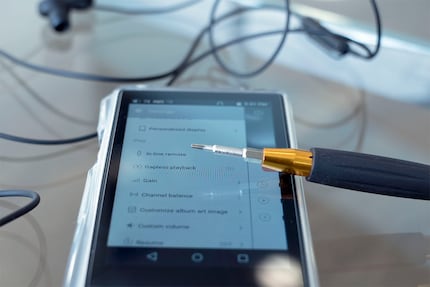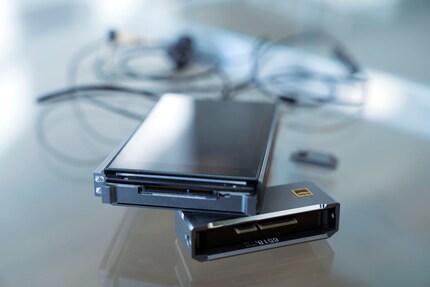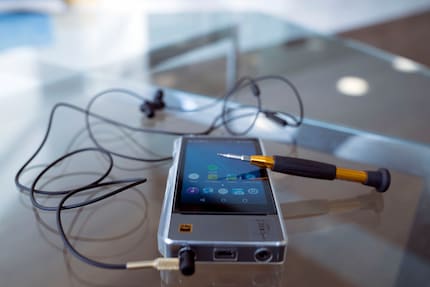
Why do MP3 players still exist?
An advert makes you sit up and take notice: MP3 players still exist. But why? Are they not yet extinct? What can such a device do? We took a look at one and discovered that the iPod of yesteryear has little in common with the MP3 players of today.
MP3 players seem to be a relic from the old days. Who needs something like that? I can still remember the days of semi-smartphones, before the iPhone came along and changed everything. You had a mobile phone - usually from Nokia - and an MP3 player - usually from Apple - in your trouser pocket or handbag. Then came the words of Steve Jobs: "One more thing" and within about two years, MP3s found their way onto smartphones and MP3 players fell by the wayside.
"Hey, man, have you seen this yet?" video producer Linus Konetschnig asks me in succinct, youthful slang. He shows me an advert that is currently running on digitec. As an editor, I'm generally less interested in adverts, which is why I've more or less ignored them so far.

"Why the hell does anyone still need one of these things?" I ask.
"No idea. Let's find out," Linus suggests.
Good idea. Less than 24 hours later, the Fiio x7 Mark II is on my desk. I laugh at the strange device on the table, which looks extremely anachronistic. A relic of a dying industry that is still breathing its last breaths?
Not at all. The Fiio x7 Mark II is an amazing little device that I could introduce as if it were something completely new. In other words, as if there had never been an MP3 player before. Because compared to my last iPod, this is a completely different machine.
A smartphone minus the phone
The Fiio x7 Mark II runs on Android, which is why the user interface immediately looks familiar. A look at the system settings shows that the manufacturer is not using the latest version, but version 5, popularly known as Lollipop. This is because Fiio has made quite massive cuts to the software so that the x7ii can be optimised for music.

By the way, if I may digress for a moment, that's the concept of Android. Android is more of a platform than a finished operating system. It is designed for communication, but also for versatile use in industry and in private life. The operating system therefore adapts extremely well to use cases that go far beyond a smartphone.
So, finished digression, back to the x7ii. The device is heavy in the hand and weighs just over 200 grams, which would be a killer argument for a smartphone of the current flagship generation. According to product management, the x7ii is the flagship MP3 player. The plus Android as well as the form factor of the device immediately make the comparison leap to mind.
Time to listen to some music. I just download Spotify and listen to some Arch Enemy because that was the last thing I listened to. I don't notice that much difference to the sound on my smartphone.
I'm doing something wrong.
A device for musicians and enthusiasts
Of course, you can easily listen to Spotify on the x7ii and enjoy hours of music and everything. But you're not doing the device justice. The true strength of the device lies in the local music.
The x7ii has two memory card slots for MicroSD cards. These are the very small ones that you also have in your smartphone. But unlike a smartphone, the x7ii has 64 GB of internal memory and can be expanded to up to 512 GB, which speaks for a lot of local music.
So what's the point in the age of Spotify? A lot, because what Spotify can't do at the time of going to press and as far as we can tell is play higher-resolution music. However, the x7ii not only plays data compiled with the Free Lossless Audio Codec (FLAC), but also its proprietary brother, the Apple Lossless Audio Codec (ALAC). This is where music lovers with expensive headphones sit up and take notice, as FLAC is the music standard of the future. Or the present. It depends on who you ask.

Fine-tuning the sound is only possible with local audio files
The settings allow you to fine-tune the sound. This means more bass, balance and a few other basic features. These can be adjusted using the standard Android settings and won't really knock anyone's socks off. But since Fiio has modified the software specifically for its players and for audiophiles, your main focus should soon move away from Spotify and Google Play Music and onto the Fiio Music app. Version 3.3.4 is installed on my player. It allows 13 fine adjustments in the rough overview, ranging from playback to gain and things I personally haven't seen since I connected a DJ amp to my PC back in 1998 (or so) to see what happens. Spoiler: Music comes out.
Yes, but you ... can the hardware handle it?
The x7ii has a built-in amplifier to ensure that the FLAC sound reaches your ear canal via expensive headphones. A screwdriver is included in the packaging. I don't immediately realise what it's for until I discover two screws on the side of the device that fit the screwdriver. A replaceable battery?
I start screwing away.
In the end, I see a rather freaky-looking connector, which is something I really don't get to see every day. And now it gets a bit nerdy. The whole module can be detached and is sold by the manufacturer as an AM3A amp. It contains an Analog Devices AD8620, an amplifier that is not only small but also powerful. I know relatively little about amplifiers, which led me to ask our resident audiophile, Fabio Endrich, what makes the amplifier so special. He briefly reads up on the technical data.

"Simply put, the amplifier in the Fiio has low distortion and stable gain," he says.
In addition, the amp is interchangeable, which is particularly appealing to enthusiasts, as there are reports online of people with soldering irons who have replaced the amp in homemade.
You also have a 3.5mm jack, an 11.5mm jack and a line/coax/AUX out. All permanently installed. Nice, isn't it?
A completely different beast
I can't tell you what the Fiio x7 sounds like. I don't want to either. Because if you make the fine adjustments the way you like them, the sound is perhaps a little more bass-heavy, perhaps a little clearer in the treble. But all in all, it can be said that the MP3 player still has a right to exist in our world. And that's a good thing, because the device shows that music on the go is not just a matter for consumers.

Definitely cool. An MP3 player of the latest generation
With the x7ii, you can listen to your sound however you want, tweak it and if you get bored, you can fall back to Spotify in seconds. It's supposed to be okay, I've heard. Fiio takes you seriously as a customer and even gives you tools so you can take your device apart. I don't currently know of any consumer electronics product that explicitly allows you to tinker with it or even encourages you to do so. So kudos to Fiio, that's really cool of you.
Journalist. Author. Hacker. A storyteller searching for boundaries, secrets and taboos – putting the world to paper. Not because I can but because I can’t not.